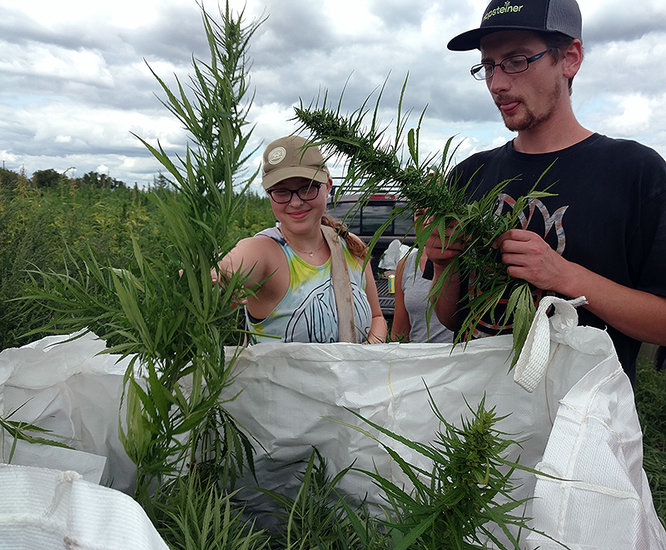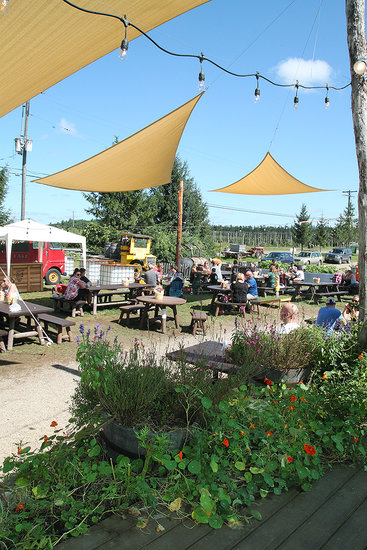Hemp proponents say it could revitalize rural economies
NEW SCOTLAND — The odor of cannabis fills the air at Indian Ladder Farms.
“The smell at night is incredible,” said Laura Ten Eyck, one of the owners of the family farm.
Indian Ladder Farms is part of recent research on an ancient crop — hemp — that for decades couldn’t be grown or studied in the United States because it is the same species as marijuana.
Ten Eyck’s curiosity about hemp came from her research on hops, a plant with cone-like flowers used to flavor beer. “It’s in the same family,” she said. “There are only three plants in the family: hops, hemp, and the hackberry tree.”
Because people have grown cannabis for thousands of years, two strains of the same species have developed: marijuana, which can contain 5 to 15 percent THC, and hemp, which in the United States must contain less than .3 percent THC to be legally grown.
THC stands for tetrahydrocannabinol, one of over 100 cannabinoids in cannabis, and the major psychoactive, or mind-altering, constituent of marijuana.
The 1970 Controlled Substance Act made it illegal to grow hemp in the United States without a permit. The Agricultural Act of 2014, known as the Farm Bill, allowed colleges to grow and conduct research on hemp.
Ten Eyck, in researching a book about hops, which is now grown at Indian Ladder Farms, became interested in hemp and hopes to write a book about that, too.
She found an assistant professor doing research at Morrisville State College, Jennifer Gilbert Jenkins, and got a permit to plant hemp at Indian Ladder Farms. One acre has been planted for fiber, and five-and-a-half acres have been planted for seed.
The crop is ready to harvest, Ten Eyck said on Saturday. The state’s Department of Agriculture and Markets came to the farm on Aug. 30 to test the THC level to be sure it is below the required .3-percent and Ten Eyck is waiting for the results.
If the crop tests higher than .3 percent in THC, Ten Eyck said, “We have to destroy it.”

Cannabis crop: Sadye Goldfarb, a student at the University of Vermont, and Alex Gillis, the assistant brewer at Indian Ladder Farms Cidery and Brewery, harvest hemp.
Hemp has a long history with humans. It was first spun into fiber 10,000 years ago. It can be refined into paper and textiles, and can be used for biofuel or food. Companies like Audi and Volkswagen use hemp to make biodegradable plastic for car interiors. Hemp can be made into concrete-like blocks for insulation, and hemp fibers can replace wood to build breathable homes.
Work done by legislators in New York’s Southern Tier led Governor Andrew Cuomo to support research projects across the state. This research is not just on industrial uses for hemp but also to explore benefits of CBDs for cosmetics and health.
CBD, or cannabidiol, is one of the cannabinoids in hemp and marijuana. This past June, the FDA approved prescription use of CBD for treatment of epilepsy. CBD, unlike THC, is not psychoactive.
While hemp has lower concentration of THC, it typically has higher concentrations of CBD than marijuana.
Humans, like other mammals, produce cannabinoids on their own and also have receptors for cannabinoids — known as CB1 and CB2 receptors. THC attaches to CB1 receptors in the brain, affecting movement, mood, appetite, and memories among other functions. CB2 receptors are more common in the immune system, affecting pain and inflammation. Researchers believe that CBD works by directing the body to use more of its own cannabinoids.
The politics
Assemblywoman Lupardo, a Democrat from Binghamton, is proud of her role in championing industrial hemp. She’s been at it for the better part of five years.
After the 2014 Farm Bill allowed growing industrial hemp for research as long as states created such programs, she and Senator Tom O’Mara, a Republican from Chemung County, sponsored legislation that created New York’s pilot research program for industrial hemp.
“I was aware that industrial hemp was being unfairly treated, locked in with the ban on cannabis plants,” said Lupardo. “And I was aware it had multiple uses, not just as textiles, but as a food source and with medicinal applications,” she said of her motivation for pushing for the legislation.
“Many New York State companies import hemp from other countries and have thriving businesses,” she went on. “There is a consumer and manufacturing demand yet we couldn’t grow it here.”
Lupardo said that, when she filed a bill to create a licensure for industrial hemp, she knew the odds were long. “We’ve come a long way,” she went on. “New York is now the number-five grower of industrial hemp in the country, and we’re number one in the Northeast … And we’re a leader in terms of research and university work on a host of topics.”
This ranges from research on fabric and textile use of hemp at the Fashion Institute of Technology in Manhattan to research on medical applications for CBD at Binghamton University. And, she said, JD Farms in Eaton, New York, near Syracuse, produces toasted hemp seeds, hemp pasta, and hemp microgreens sold at Whole Foods.
Once the first bill became state law, Lupardo was distressed that, after experiments were completed on the hemp, it had to be destroyed. “It’s a valuable crop,” said Luparado. “Then, the federal government said, you can manufacture, transport, and sell what you grow.”
She and O’Mara then sponsored other bills to allow for the transportation, processing, sale, and distribution of hemp. Now, 115 licenses have been issued.
Lupardo says that Mitch McConnell, the Senate majority leader, “has been the driving force behind what has been allowed up to this point.”
“His Kentucky constituents want to convert from tobacco to hemp,” she said. McConnell believes hemp could boost rural economies in his home state of Kentucky; he backed pilot programs that have made his state a leader in the field.
McConnell wants farmers to be able to grow hemp legally, and in April introduced legislation that would remove non-psychoactive cannabis from the definition of marijuana in the Controlled Substances Act. Currently, marijuana is a Schedule 1 drug, like heroin.
“We are blocked from the ultimate expansion,” said Lupardo of growing industrial hemp.
Both of New York’s senators — Chuck Schumer, the Senate minority leader, and Kirsten Gillibrand — support the Hemp Farming Act.
Like McConnell, Lupardo believes allowing unfettered hemp productions would benefit upstate New York economies. Binghamton, which Lupardo represents, used to have a thriving economy, producing computers and shoes, she said, adding that many upstate regions depended on manufacturing, which is no longer there.
“I’m hoping to rebuild our farming economy — which is pretty strong — and to add a lucrative manufacturing sector,” said Lupardo.
“I’d be surprised if it doesn’t pass this year,” Lupardo said of McConnell’s Hemp Farming Act. Currently, she said, the merits of McConnell’s proposal aren’t being argued, merely the details — like prohibiting those with prior drug arrests from growing hemp.
If the legislation does go through, many barriers — from banking to inter-state transport — would be lifted. Lupardo explained about banking, by way of example.
“Right now, it’s difficult to get loans for startups and experiments because of the federal government,” she said. “The governor said state-chartered credit units could be used, but we don’t have many of them.”
Also, she said, federal research dollars are needed. “We need the federal government to get out of the way,” Lupardo said. “There are too many states with economies tied up in this.”
Lupardo said that 50 of the 115 licenses in New York State for hemp research have to do with CBD. She was asked, if the Hemp Farming Act of 2018 does pass, would the Food and Drug Administration or the Drug Enforcement Administration have jurisdiction over the extraction and marketing of CBD
“That’s the $64 million question,” Lupardo answered.
The science
Gilbert Jenkins, a soil scientist, is in her third year of hemp research. She said the State University of New York College of Agriculture and Technology at Morrisville got involved when one of the farmers working with Lupardo was looking for a research partner.
“We were the first permit holder in the state,” said Gilbert Jenkins.
The first year, 30 acres of hemp were planted in Georgetown, New York; the second year, 80 acres were planted on the Morrisville campus; and this year, Morrisville has 40 acres on campus and another 80 acres of hemp on partner farms like Indian Ladder.
“My research focus is on best practices for hemp production,” Gilbert Jenkins said, which includes nutrient management and weed suppression. She noted, “In hemp production, weeds are one of the most significant problems.”
“At Indian Ladder Farms,” she said, “we are trying to investigate organic amendments versus conventional amendments.”
In one area, a cover crop was used. “We planted winter rye to choke out the weeds in the spring,” said Ten Eyck.
In a second area, conventional treatment was used — Roundup. And in a third area, a combination of vinegar and citric acid was used.
Results haven’t been finalized yet, Gilbert Jenkins said. But pressed for even anecdotal observation, she said, “Organic amendments seemed to hold back weed pressure early on but didn’t have staying power.”
The areas treated with Roundup had fewer weeds. A more concentrated version of the organic solution may prove more effective, she speculated.
As a side note, Gilbert Jenkins added, “The science behind Roundup safety is really misunderstood … I wouldn’t drink it, but it breaks down in two weeks … It works on plant metabolism, which is totally different than human metabolism.”
She concluded, “In agriculture in general, we need integrated pest management, using chemicals as a last resort.”
Gilbert Jenkins said that marijuana and hemp are the same species. “The THC level is the only difference,” she said.
She likened it to grain corn and sweet corn being of the same species, noting that grain corn is “disgusting” to eat while sweet corn is delicious. “The difference is they have been bred so that one accumulates starch and the other sugar,” she noted.
Cannabis has been bred for centuries, Gilbert Jenkins said. In the 1960s, marijuana had 6 to 10 percent THC and now it can have as much as 15 percent, she said. For hemp to be legally grown in New York State, it must have less than .3-percent THC. The amount of THC is being bred down, she said.
“Last year, our fields tested at 10 times lower than that — .03 percent,” said Gilbert Jenkins.
“They want to make sure people can’t get high off of industrial hemp,” she said.
Gilbert Jenkins also noted, “We’ve got a hundred years’ worth of research on corn, soy, and wheat.” But research on hemp is much more limited. She said research in Canada and Europe had been going on for about two decades.

The beer garden at Indian Ladder Farms Cidery and Brewery is hopping on Saturday.
From hops to hemp
“Support your local hops farmer,” says the back of Dietrich Gehring’s T-shirt as he works Saturday in the bustling beer garden at Indian Ladder Farms. He is stationed in a kitchen with stainless-steel appliances. He bought two military kitchens — for $4,400, combined — as government surplus; the kitchens had been used at an Air Force base in Afghanistan.
Now the military kitchen functions under a tent for three seasons at Indian Ladder Farms — spring, summer, and fall.
The area used to be a utilitarian part of the farm — for spraying and keeping Dumpsters. Now it is filled with picnic tables and gaiety. Huge pots of flowering plants line the beer garden and laughter fills the air.
The farm for decades has attracted suburban and urban families who pick apples or berries and flock especially in the fall to drink fresh cider and eat cider doughnuts. Parents bring their kids to Baby Animal Daze and learn where their food comes from.
Now, locally-brewed beers, some of it made from hops grown on the farm, have brought in “a little more alternative crowd,” said Ten Eyck.
Ten Eyck and Gehring — a married couple — grew up together in New Scotland and have long lived on the farm where they raised their son, Wolfgang, now a senior at the Fashion Institute of Technology. In recent years, Peter Ten Eyck II has passed the running of the century-old family farm on to his daughter, Laura Ten Eyck, who manages the business side, and his son, Peter Ten Eyck III, who oversees the farming.
Gehring had long been a home brewer. “He’s obsessed with beer,” said his wife with a smile. But, she said, it was the state’s Farm Brewing Act that got them to grow hops. “It gave you special permission to serve beer from glasses and created a market for New York hops,” she said, since a percentage of the ingredients for the beer must be produced in New York State.
It was then a natural step, with the Indian Ladder orchards at hand, to become a cidery as well as a brewery.
“We sell value-added product direct to the consumer,” said Ten Eyck.
Gehring has partnered with Stuart Morris, a friend from college years, to run the cidery and brewery.
Stuart, Gehring, and Ten Eyck all went to college in Boston. Morris was at Northeastern, Gehring at the New England School of Art and Design, and Ten Eyck at Emerson College. The trio worked at Beacon Hill Wine and Spirits, which also sold beer.
Ten Eyck and Gehring wrote a book four years ago on how to grow hops. “The Hop Grower’s Handbook” is published by Chelsea Green Publishing. “It’s the how-to basics combined with life on the farm, to make it more readable,” said Ten Eyck.

A combine harvests hemp seed on Sept.19 at Indian Ladder Farms.
“Hops had not been grown in New York for 100 years,” said Ten Eyck. “Everyone had to learn from scratch.”
In the 1800s, the local area was famous for its hops. “It was a huge monoculture,” said Ten Eyck, making the hops vulnerable to insects and disease. “Certain diseases are worse with lots of rain here; it took hold,” said Ten Eyck.
She went on, “As people moved out west, they brought hops with them.” The hops industry thrived in places like the Yakima Valley, which is arid desert, but easily irrigated with the Yakima River.
“Then Prohibition came,” said Ten Eyck, sealing the fate of New York’s hops industry.
Similarly, the Controlled Substance Act a half-century ago quashed hemp production in the United States but the Agricultural Act of 2014 opened the door a crack, at least for research.

Laura Ten Eyck wrests a flower of hemp from one of the plants at Indian Ladder Farms
Through the cracked door
On Saturday, Ten Eyck walks along the edge of the field planted with the hemp for fiber. She explains that the hemp there was planted at twice the density to grow taller.
Next to the acre of hemp are tall poles with hops growing on them. She explains that hops is a climbing bine, emphasizing the “b” to distinguish the word from “vine.” A vine wraps around a pole or cord with tendrils, she explains while a bine, like hops, has a prickly stem that lets it stick to a pole like velcro.
Ten Eyck stops to pick a hops flower and crushes it in her hand. A pungent odor emerges. Hops, she explains have trichomes — from the Greek word for “hair” — that are similar to the trichomes in hemp.
“Hops secrete a chemical like nettles — it’s itchy,” Ten Eyck says.
The same stickiness and odor is evident when, a few minutes later, Ten Eyck walks to the field with the hops planted for seed and crushes some in her other hand. “The trichomes are inside the bud,” she says.
Terpenes — made up of carbon and hydrogen — are synthesized inside the trichomes of both hops and hemp and are often used in fragrances or flavorings; they are responsible for the smell of cannabis.
“They provide the flavor and aroma in beer — some are like lemon and others like pine,” said Ten Eyck. “Cannabis has the same kind of terpenes as hops. In the West, they extract terpenes, as liquids, that brewers buy.”
The Green House Seed Co. performed a spectral analysis to identify the terpenes in each of its cannabis strains, and created a flavor wheel to help patients using medical marijuana to choses which strain they wanted for a particular effect. The Food and Drug Administration has recognized terpenes as safe.
If the THC level in the Indian Ladder Farms’ crops is below the state limit, Ten Eyck said, the seed crop will be harvested with a combine and dried. “We’ll try malting it, like barley,” she said.
She has an original idea on what to do with the acre of hemp grown for fiber. Currently, the farm’s hops grow up poles and across strings of coir, made of coconut husks from Sri Lanka.
“You need fibrous cord for hops,” said Ten Eyck. “We’re going to experiment with fiber from hemp.”
She explained the process, saying, “We’ll cut it, then let it lay in the field. It’s called retting.” Moisture on the cut plants will help separate the fiber from the stem.
“The stem has to fall off,” said Ten Eyck. “We’ll keep turning it, then bail it.” The raw material will be taken to a processor to turn it into cord.
She concluded of the pending inaugural hemp harvest at Indian Ladder Farms, “We’re just trying it out for the first time … In general, people are not far along with this ... Cannabis growers have a huge amount of experience, but it’s clandestine because of federal law.”
Ten Eyck hopes that the next Farm Bill — in which Congress every few years sets agricultural and food policy for the country — will legalize hemp.
Ten Eyck credits her and her husband’s ability to take on diverse new challenges to their background. “Deiter and I both have creative backgrounds,” she said. “When you’re a creative person, you’re able to work with the unknown.”
In addition to raising and marketing crops, and writing about the experience, Gehring is also a photographer and Ten Eyck, who majored in creative writing at Emerson (and is a one-time reporter for The Altamont Enterprise), remembers learning about “negative capability” from one of her writing professors.
John Keats, a Romantic poet, coined the phrase to describe how great writers can pursue a vision of beauty even when their pursuit takes them through turmoil and uncertainty. Keats described negative capability this way in an 1817 letter to his brothers: “when a man is capable of being in uncertainties, mysteries, doubts, without any irritable reaching after fact and reason.”
“It’s like when you’re writing a novel,” said Ten Eyck, “and you continue to move forward even in a state of chaos. You still progress. Not everyone can do that.”



